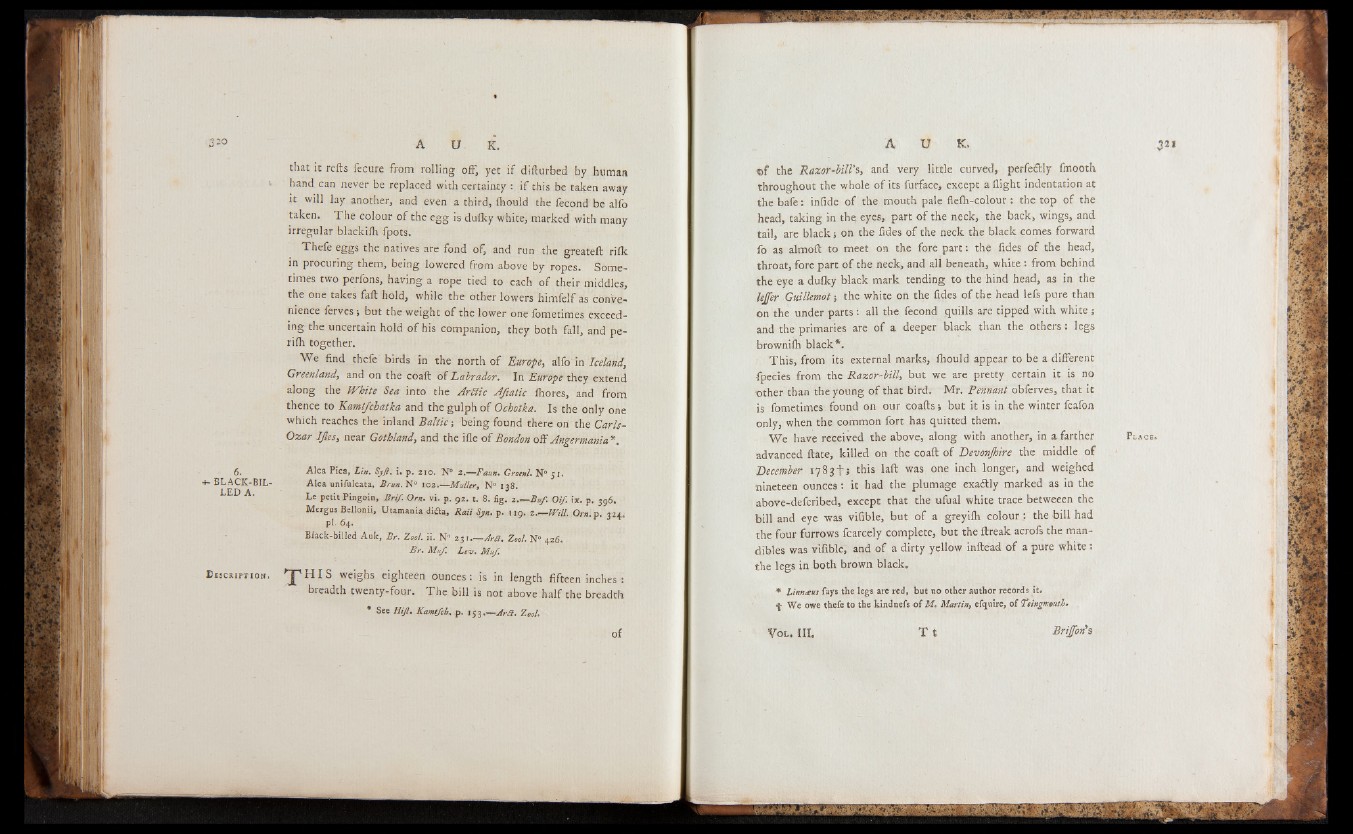
3 20 a u k .
that it refts fecure from rolling off, yet if difturbed by human
hand can never be replaced with certainty : if this be taken away
it will lay another, and even a third, fhould the fecond be alfo
taken. The colour of the egg is dufky white, marked with many
irregular blackifh fpots.
Thefe eggs the natives are fond of, and run the greateft rifk
in procuring them, being lowered from above by ropes. Sometimes
two perfons, having a rope tied to each of their middles,
the one takes fall: hold, while the other lowers himfelf as convenience
ferves, but the weight of the lower one lometimes exceeding
the uncertain hold of his companion, they both fall, and pe-
rifh together.
We find thefe birds in the north of Europe, alfo in Iceland,
Greenland, and on the coaft of Labrador. In Europe they extend
along the White Sea into the Aräic Afiatic fhores, and from
thence to Kamtjcbatka and the gulph of Ochotka. Is the only one
which reaches the inland Baltic; being found there on the Carls-
Ozar Ifles, near Gothland, and the file of Bondon off Angermania*.
6.
+- BLACK-BILLED
A.
Alca Pica, Lin. Syft. i. p. 210. N"° 2.— Faun. Grotnl. N° 51.
Alca unifulcaca, Bran. N° 102.—Muller, N° 138.
Le petit Pingoin, Brif. Ora. vi. p. 92. t. 8. fig. 2.— Buf. Oif. ix. p. 396.
Mergus Beilonii, Utamauia dicta, Raii Syn. p. 11-9. 2.— Will. Or«.p. 324.
pi. 64.
Black-billed Auk, Br. Zool.iu N" 231__Ar3. Zool N» 426.
Br, Muf, Lev. Muf.
Description. X H I S weighs eighteen ounces: is in length fifteen inches :
breadth twenty-four. The bill is not above half the breadth
* See Hiß. Kamtjih. p. 133.— ArB. Zool.
of
À U K, 32*
©f the Razor-bill’s, and very little curved, perfectly fmooth
throughout the whole of its furface, except a flight indentation at
the bafe: infide of the mouth pale flelh-colour : the top of the
head, taking in the, eyes, part of the neck, the back, wings, and
tail, are black; on the Tides of the neck the black comes forward
fo as almoft to meet on the fore part: the fides of the head,
throat, fore part of the neck, and all beneath, white: from behind
the eye a dulky black mark tending to the hind head, as in the
lejjfer Guillemot 5 the white on the fides of the head lefs pure than
on the under parts : all the fecond quills are tipped with white ;
and the primaries are of a deeper black than the others; legs
brownilh black*.
This, from its external marks, fhould appear to be a different
fpecies from the Razor-bill, but we are pretty certain it is no
other than the young of that bird. Mr. Pennant obferves, that it
is fometimes found on our coafts s but it is in the winter feafon
only, when the common fort has quitted them.
We have received the above, along with another, in a farther
advanced ftate, killed on the coaft of Devonjhire the middle of
December 1783 + 5 this laft was one inch longer, and weighed
nineteen ounces : it had the plumage exaftly marked as in the
above-defcribed, except that the ufual white trace betweeen the
bill and eye was vifible, but of a greyilh colour : the bill had
the four furrows fcarcely complete, but the ftreak acrofs the mandibles
was vifible, and of a dirty yellow inftead of a pure white :
the legs in both brown black.
* Limans fays the legs are red, but no other author records it.
f We owe thefe to the kindnefs of M. Martin, efquire, of Teingmauth.
T t
P la ce .
VOL. III. Brijfon's